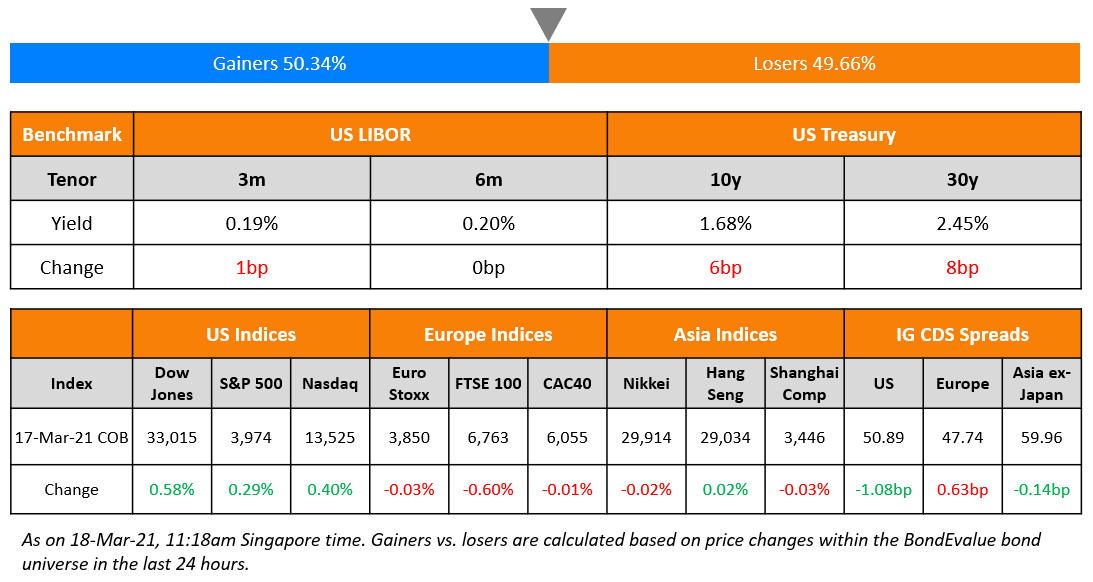This site uses cookies to provide you with a great user experience. By using BondbloX, you accept our use of cookies.
| | | | | | | | | | | | | | | | | | | | | | | | | | | | | | | | | | | | | | | | | | | | | | | | | | | | | | | | | | | | | | | | | | | | | | | | | | | | | | | | | | | | | | | | | | | | | | | | | | | | | | | | | | | | | | | | | | | | | | | | | | | | | | | | | | | | | | | | | | | | | | | | | | | | | | | | | | | | | | | | | | | | | | | | | | | | | | | | | | | | | | | | | | | | | | | | | | | | | | | | | | | | | | | | | | | | | | | | | | |
Bond Market News
Macro; Rating Changes; New Bond Issues; Talking Heads; Top Gainers & Losers
February 16, 2021

US equity markets were shut on Monday on account of President’s Day. US 10Y Treasury yields have moved another 4bp higher, currently at 1.25% with overall risk sentiment positive. WTI crossed $60/bbl, up 2.2%, the highest level in over a year and Brent also rallied 1.1% to $63.1/bbl on account of Middle East tensions after a Saudi-led coalition fighting in Yemen said it intercepted an explosive-laden drone fired by the Iran-aligned Houthi group and an Arctic freeze expected to extend till Texas, which is undergoing severe power outages amid heavy snowfall. European equities saw a strong rally with the CAC and FTSE up 1.5% and 2.5% while DAX moved 0.4% higher. German Bund yield also rose above -0.4%, the first time since September. EU main CDS spreads tightened 1.2bp and crossover spreads tightened 6bp. Asian primary markets continued to remain muted due to the Lunar New Year holidays and have opened with a positive bias today, up ~0.5% while Asia ex-Japan CDS spreads are 0.2bp tighter.
Bond Traders’ Masterclass
If your first language is Spanish and you are keen on learning the fundamentals of bonds, do join our masterclass on A Practical Introduction to Bonds, which will be conducted in Spanish on February 17 at 9am Mexico City / 3pm London / 7pm Dubai. The session will be conducted by bond market veterans that have previously worked at premier global institutions such as HSBC and Citibanamex. Click on the image below to register.
New Bond Issues

New Bond Pipeline
- HCL Tech $ bond
- JSW Steel $ bond
- Liberty Mutual Group
Rating Changes
Term of the Day
Option Adjusted Spread (OAS)
Option Adjusted Spread (OAS) refers to a measure of the credit spread of a bond with embedded options relative to a benchmark, similar to the z-spread. The key difference between OAS and z-spread lay in the optionality. When comparing two bonds – one with an embedded option and one without – OAS is a better measure compared to z-spread as the former adjusts for/removes the impact of optionality for a like-to-like comparison. Put simply, OAS ≈ Z-Spread + Option cost.
On a technical note, the above formula is not an exact equation as the z-spread is calculated from the spot curve while the OAS is calculated from the forward curve. The OAS is less than the z-spread for callable bonds and greater than z-spread for puttable bonds.
Talking Heads
On the bond market reflation trade proving resilient
Ben Emons, managing director of global macro strategy at Medley Global Advisors
“The confluence of more fiscal support and the reopening of the economy hitting together around springtime is lifting the outlook for inflation and growth,” said Emons. “Rising breakevens and the steepening yield curve show that some people are trading already on the future economy — post the pandemic.”
Michael Pond, global head of inflation-market strategy at Barclays
While the CPI report “was a disappointment, it does not change our outlook and we do not expect it will change investors’ views about expected reflation,” Pond wrote. “The reflation theme is based on a story about where inflation will go once most are vaccinated and demand normalizes.”
On riskiest borrowers comprising biggest share of junk-bond deals since 2007
Oleg Melentyev, an analyst at Bank of America
“Last year it was the strongest companies that reacted to unprecedented events by shoring up their balance sheets in case cash was needed,” said Melentyev. “Now we are deep at the bottom of the barrel in terms of the weakest and most fragile issuers finally being able to fund themselves in this market.”
Jerry Cudzil, head of credit trading at TCW
“The prudence that may have been there before is now non-existent,” said Cudzil. “In the near to medium term you will have a difficult time keeping up if you don’t buy some of this stuff. That doesn’t mean they are good deals. As a matter of fact, it’s a good way to lose money long term.”
“The way the market is viewing this right now is basically saying, if all these triple-Cs can access funding, they’re not going to default,” said Melentyev. The problem, he said, is investors are “hoping that this argument will work longer than it probably will.”
“We believe income investors should maintain exposure to high yield bonds in this environment. With the Fed on hold, interest rate volatility may remain at low levels. A sharp, unexpected rise in rates is certainly a risk investors must be aware of. Higher yields, however, can provide a cushion against rising rates, and higher growth is positive for spreads.”
“Emerging markets high yield bonds also compare favorably to US high yield bonds in terms of quality, particularly in light of the significantly higher spread levels… Emerging markets high yield corporates have generally exhibited impressive discipline over the past few years, and have lower leverage and higher interest coverage ratios compared to US high yield. Default rates have historically been lower than US high yield, and that was also true in 2020.”
On longer-term dollar Gulf bonds falling as US Treasury yields rise
Sergey Dergachev, a fund manager at Union Investment
“Since most GCC (Gulf Cooperation Council) sovereigns (apart from high-yield countries Bahrain and Oman) are investment-grade rated (they) do react relatively strongly on underlying development in U.S. and EU rates,” said Dergachev.
Raffaele Bertoni, head of debt capital markets at Gulf Investment Corporation
On yield on 10-year US Treasuries, “in my view, 1.25% is a critical level. Above that, highly rated issuers should suffer because of their tight spread and high correlation with risk-free yields,” said Bertoni.
Top Gainers & Losers – 16-Feb-21*

Go back to Latest bond Market News
Related Posts:









